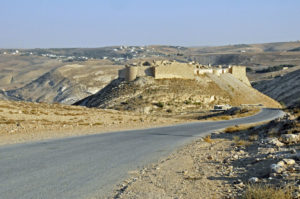
Shobak Castle in Jordan (Photo by Don Knebel)
On July 15, 1099, knights of the First Crusade captured Jerusalem from the Muslims and established the Kingdom of Jerusalem. In 1115, Baldwin I, the first King of Jerusalem, built an imposing stone fortress atop an isolated conical mountain east of the Jordan River to control trade between Damascus and the Red Sea. Named Krak de Montreal (Castle of the Royal Mountain) to reflect the king’s contribution to its construction, the fortress marked the eastern dividing line between Christian and Muslim territories. Because of its design and location, Krak de Montreal withstood a number of assaults. In 1187, after recapturing Jerusalem, Saladin began an 18-month siege of the fortress. Starving defenders exchanged their wives and children for food and reportedly went blind from lack of salt. Running out of both food and wives, the Christians surrendered in May 1189. Saladin, known both for his skill in battle and magnanimity in victory, repatriated the wives and children.
The Mamelukes modified the fortress in the fourteenth century and it gradually fell into disrepair. The partially-restored fortress, now known as Shobak Castle after its name in Arabic, lie in a still remote region along the highway that connects Amman to the Gulf of Aqaba. Visitors can see the remains of two churches from the Crusader period and large rocks used in unsuccessful efforts to attack the fortress with catapults. They can also see writings from the Quran carved in stone and a simple throne, both probably from the time of Saladin.
Medieval fortress ruins are not for everyone. But for anyone wanting to see a Crusader castle with an interesting history, Shobak Castle should be on the list.
Comments are closed.